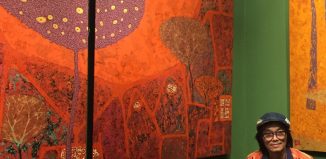KVT at Art Vietnam
Large group shows are just so overwhelming to comment on. So I thought that as this one was at Art Vietnam (where you can always be assured of quality art work being exhibited) I’d invite some visiting art history and curatorial students to give collaborative opinions. So I handed over most gallery spaces to one native English speaking visitor and one young Vietnamese art student each. Here are their impressions.
Tina and Linh took the downstairs reception lounge and agreed that although the three artists exhibited there were all interesting they’d have liked to see the space given over entirely to Dinh Cong Dat’s wooden animal sculptures. The two saw these as a radical departure from his polished and refined work that seemed to start with those fascinating resin ants and popular masks and the plasticky binary students and contemplative figures. Linh described the sometimes narrative display of Dat’s invasive ants in other venues and both wondered if the partially painted animals would ever be used in a Jake and Dinos Chapman narrative where the primitive style is used to make a social statement. Dat’s new work is exciting and the possibilities fascinating.
Stacey and Hoa wanted all but one of Peter Steinhauer’s photographs removed and a lone light allowed to illuminate the new print Hong Kong tenements. They stated that all such work immediately brings Andreas Gursky’s large scale photographs to mind but that a master like Steinhauer has his own distinct stamp. They could see how Steinhauer’s misty, almost spiritual feeling work would impact on a lot of viewers but they preferred the more industrial grittiness of the lone piece.
Thinh and Rufe wanted to see a small room devoted to just a few of Bradford Edwards’ assemblages. Both were totally fascinated by the historical perspective but decided that for them the camera constructions, the montage of transistor radios and a couple of 45 records would be a great three monkeys statement with the violin filled with incense sticks requiring a lot of its own space. Thinh wants to know if the artist intends to convert a whole orchestra and if so contends that it will be an installation worth 5 illuminated stars.
Ngoc and Anne were really impressed with Marita Nurmi’s painted student tables. They initially didn’t like the fact that they were confined to stairwells and landings but after a couple of viewings were pleased with the placement of the triptychs which all worked perfectly together. Both would have left out the early pieces and started with the Sonia Delaunay table at the bottom of the stairs. Both were impressed with Nurmi’s appropriation of a ready made as a support and with the feminization of them. They could both see them installed as an expansive floor piece but liked the fact that the discreteness of the feminine patterning stole upon you as you climbed, descended and turned. They would have dedicated all the stairwells to the tables, even up to the top, inaccessible landings. Anne thought that Nurmi’s work has a similar impact as Beatriz Milhazes and like hers is full of feminine connotations while playfully referencing other female artists such as Brigit Riley.
Tod and Phat took on Ly Tran Quynh Giang and her room of Sadness. Phat explained the wonder of Giang’s utterly bodacious exhibition of woodcut sculptures at L’Espace in 2008 which rightfully places Giang in the forefront of Vietnamese artists. But whether they’d have placed some of these works with the oils remained contentious. The Sadness Series is also bodacious and a huge Vietnamese feminist statement (as distinct from feminine) The oils, they said, are pulled with intensity across the canvasses wrapping the almost bewildered figure in confining, conforming cloths. They got the feeling that Giang’s push and pull of paint might soon leave her canvasses figureless, the female obliterated under the slathers. Sadness V which had the figure humped beneath a dowdy blanket was the saddest of all.
In the main gallery Gillian and Huong were blown away with the large paintings by Nguyen Van Phuc. These pieces, they declared and the rest unanimously agreed, were the pieces des resistance of the exhibition. These almost voyeuristic self portraits with their overt hints of sexual ambiguity were placed by the two in the same genre as the enigmatic 1980’s work of Eric Fischl. The two paintings they might have deleted were the Star Protector and First Flag. We all want more, more, more.
At the very top of the tree was the unstretched work of Nguyen Cam making the space into its own sort of earthy stained glass cathedral.
Uh oh, says Anne, we need a large, spare white wall so that Nguyen Bach Dan can do one of his monochromatic brush paintings directly on to it, and another space around a bend where the diptych Contradiction by Nguyen Thi Chau Giang can suddenly confront you and another space where the feminist dream spaces of Dinh Thi Tham Poong can make you ponder….or perhaps leave them for next time so our heads aren’t in a whirl.
Whatever you do, don’t miss out on seeing Phuc’s oils! ![]()
| Not a reviewer, not a critic, “Kiếm Văn Tìm” is an interested, impartial and informed observer and connoisseur of the Hanoi art scene who offers highly opinionated remarks and is part of the long and venerable tradition of anonymous correspondents. Please add your thoughts in the comment field below. |
















